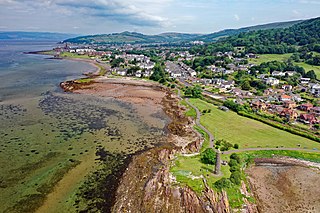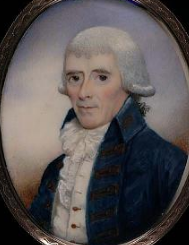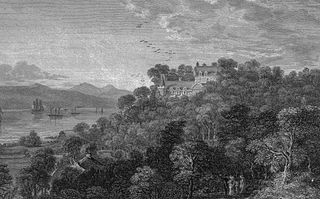
A helmet is a form of protective gear worn to protect the head. More specifically, a helmet complements the skull in protecting the human brain. Ceremonial or symbolic helmets without protective function are sometimes worn. Soldiers wear combat helmets, often made from Kevlar or other lightweight synthetic fibers.

Skelmorlie is a village in North Ayrshire in the southwest of Scotland. Although it is the northernmost settlement in the council area of North Ayrshire it is contiguous with Wemyss Bay, which is in Inverclyde, and has a PA zone postcode unlike the rest of Ayrshire which is in the KA zone. The dividing line is the Kelly Burn, which flows into the Firth of Clyde just south of the Rothesay ferry terminal. Despite their proximity, the two villages have historically been divided, Skelmorlie in Ayrshire and Wemyss Bay in Renfrewshire.

Largs is a town on the Firth of Clyde in North Ayrshire, Scotland, about 33 mi (53 km) from Glasgow. The original name means "the slopes" in Scottish Gaelic.
A visor was an armored covering for the face often used in conjunction with Late Medieval war helmets such as the bascinet or sallet. The visor usually consisted of a hinged piece of steel that contained openings for breathing and vision. Appropriately, breaths refers to the holes in the metal of the visor. Visors protected the face during battle and could be remarkably durable. One surviving artifact was found to be "equivalent in hardness to cold worked high speed steel."

The sallet was a combat helmet that replaced the bascinet in Italy, western and northern Europe and Hungary during the mid-15th century. In Italy, France and England the armet helmet was also popular, but in Germany the sallet became almost universal.

The bascinet – also bassinet, basinet, or bazineto – was a Medieval European open-faced combat helmet. It evolved from a type of iron or steel skullcap, but had a more pointed apex to the skull, and it extended downwards at the rear and sides to afford protection for the neck. A mail curtain was usually attached to the lower edge of the helmet to protect the throat, neck and shoulders. A visor was often employed from c. 1330 to protect the exposed face. Early in the fifteenth century, the camail began to be replaced by a plate metal gorget, giving rise to the so-called "great bascinet".

James Cunningham, 14th Earl of Glencairn was a Scottish nobleman, soldier and patron of Robert Burns.

Clan Cunningham is a Scottish clan. The traditional origins of the clan are placed in the 12th century. However, the first contemporary record of the clan chiefs is in the thirteenth century. The chiefs of the Clan Cunningham supported Robert the Bruce during the Wars of Scottish Independence. In the 15th and 16th centuries, the Clan Cunningham feuded with the Clan Montgomery. Historically, the chief of Clan Cunningham held the title of Earl of Glencairn. However, in modern times the chief of the clan is Cunningham of Corsehill. On 18 December 2013, Sir John Christopher Foggo Montgomery Cunninghame, Baronet of Corsehill, was recognized by Lord Lyon as Clan Chief after the chiefship had been vacant for over 200 years.

Clan Montgomery is a Scottish clan of the Scottish Lowlands.

Kilbirnie Auld Kirk is a Church of Scotland congregation on Dalry Road, Kilbirnie, North Ayrshire, Scotland. Although the building dates back to the 15th century, the present congregation was formed in 1978 by the amalgamation of the Glengarnock Parish Church and the Barony Church. The building is now closed as a place of worship, and the congregation meet at the united Kilbirnie New Parish Church in Glasgow Street.

The Skelmorlie Aisle of Largs Old Kirk is the remains of a church in the town of Largs, Ayrshire, Scotland.

Greenwich armour is the plate armour in a distinctively English style produced by the Royal Almain Armoury founded by Henry VIII in 1511 in Greenwich near London, which continued until the English Civil War. The armoury was formed by imported master armourers hired by Henry VIII, initially including some from Italy and Flanders, as well as the Germans who dominated during most of the 16th century. The most notable head armourer of the Greenwich workshop was Jacob Halder, who was master workman of the armoury from 1576 to 1607. This was the peak period of the armoury's production and it coincided with the elaborately gilded and sometimes coloured decorated styles of late Tudor England.

Skelmorlie Castle stands on the eastern shore of the Firth of Clyde, Scotland, at the north-western corner of the county of Ayrshire. The structure dates from 1502, and was formerly the seat and stronghold of the Montgomery Clan. The modern village of Skelmorlie lies to the north of the castle.

St Lawrence's Church is a redundant Anglican church in the parish of Snarford, Lincolnshire, England. It is recorded in the National Heritage List for England as a designated Grade I listed building, and is under the care of the Churches Conservation Trust. The church stands to the north of the A46 road between Market Rasen and Lincoln. It is a medieval building containing impressive 16th- and 17th-century monuments.

The Brisbane Aisle is a small 17th century free-standing burial vault, built for the Shaws of Kelsoland and situated in the grounds of the 'Largs Old Kirk', Largs, Ayrshire, Scotland.
The Brocas helm is a jousting helm on display at the Rotunda as part of the Tower of London armoury collection. It was commissioned by an English knight from an Italian armourer.

The Murder of Hugh Montgomerie, 4th Earl of Eglinton at the Annick Ford in Stewarton, East Ayrshire, Scotland, took place in 1586 as a consequence of a long running feud between the Montgomeries, Earls of Eglinton and the Cunninghames, Earls of Glencairn, families who were competing for power and influence locally and nationally. The significant repercussions of this act were felt throughout the county of Ayrshire and beyond. The spelling 'Montgomerie' is used throughout for both the family and Montgomery for the clan and clan and district names 'Cunninghame' in the same fashion.

The Glencairn Aisle or Glencairn Vault at Kilmaurs, East Ayrshire is a Category B Listed vaulted sepulchral chapel. Built as a place for private contemplation and prayer, it also contains a large memorial monument, as well as the burial crypt of the Cunningham Earls of Glencairn and their family members. An 'aisle' is defined as a structure normally attached to a church, which may have burial crypt below, a family pew above, and sometimes a retiring room, as at the Glencairn Aisle.

The Kennedy Aisle or Bargany Aisle at Ballantrae, South Ayrshire is a vaulted burial chamber and crypt containing a large mural memorial, the Kennedy Monument, an ornately carved stone monument dated to between 1602 and 1605 that commemorates Gilbert Kennedy of Bargany and Ardstinchar, his wife, Janet or Jean Stewart, who died in 1605 and three of their children.

The Tomb of the Wolf of Badenoch consists of a 15th-century tomb effigy and altar tomb, both of which are carved from marble. It is located in Dunkeld Cathedral, Perthshire, Scotland, and was built for Alexander Stewart, Earl of Buchan, who is buried underneath.




















